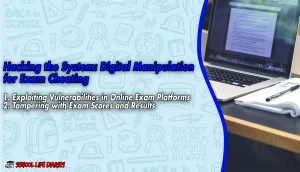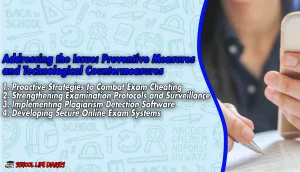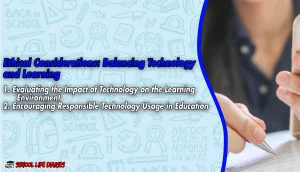In today’s fast-paced world, technology has become an integral part of our daily lives, influencing various aspects, including education. While technology has undoubtedly revolutionized learning methods and provided countless opportunities for students, it has also opened the door to unethical practices, particularly when it comes to exams How to Cheat in Exams Using Technology.
In this comprehensive analysis, we will delve into “How to Cheat in Exams Using Technology,” exploring the dark side of technology-enabled cheating methods and examining the tools and techniques students use to gain an unfair advantage.
By examining the ethical implications, discussing preventive measures, and evaluating the impact on the learning environment, we aim to shed light on this pressing issue and emphasize the importance of upholding academic integrity in the face of technological advancements.
The Dark Side: Exam Cheating and Technology
While technology has been a game-changer in education, it has also given rise to ethical concerns, including exam cheating. Cheating in exams not only compromises the integrity of the educational system but also undermines the effort and fairness of honest students.
The accessibility and sophistication of technology have made it easier for students to employ cheating methods, posing significant challenges to educational institutions.
1. Exploring the Ethical Implications of Cheating in Exams:
Cheating undermines the principles of fairness, honesty, and meritocracy that form the foundation of education. It erodes trust between students, educators, and educational institutions, and devalues the learning process itself. Understanding the ethical implications of exam cheating is crucial to address the issue effectively and maintain the integrity of assessments.
2. The Rise of Technology-Enabled Cheating Methods:
Technology has provided students with new avenues for cheating in exams. From smartwatches and hidden earpieces to smartphone applications and communication platforms, students have found innovative ways to gain an unfair advantage.
Additionally, hidden cameras, micro cameras, programmable calculators, and smart pens have become tools of deception. These advancements in technology have made it increasingly challenging for educators and institutions to detect and prevent cheating.
Technological Tools for Exam Cheating
To fully grasp the extent of technology’s influence on exam cheating, it is important to explore the specific tools and techniques used by students to cheat.
1. Smartwatches and Hidden Earpieces:
Smartwatches with messaging capabilities and hidden earpieces have become popular devices for covert communication during exams. Students can discreetly receive answers or prompts from external sources, enabling them to cheat without attracting suspicion.
2. Smartphone Applications and Communication Platforms:
The widespread use of smartphones has led to the development of applications specifically designed to aid in exam cheating. These applications provide access to pre-written answers, formula calculators, and instant messaging platforms, allowing students to collude and share answers in real time.
3. Hidden Cameras and Micro Cameras:
Advancements in miniaturization have made it possible for students to use hidden cameras or micro cameras to capture exam questions or transmit images to collaborators outside the examination hall. This method enables remote assistance, undermining the fairness and integrity of the assessment process.
4. Programmable Calculators and Smart Pens:
Programmable calculators and smart pens have been modified to store text, formulas, or even entire essays. These devices allow students to conceal answers or reference material within seemingly innocuous tools, granting them an unfair advantage during exams.
Hacking the System: Digital Manipulation for Exam Cheating
In addition to using technology as a direct means of cheating, some students resort to hacking and digital manipulation to exploit vulnerabilities in online exam systems.
1. Exploiting Vulnerabilities in Online Exam Platforms:
Online exam platforms may have vulnerabilities that can be exploited by tech-savvy students. By circumventing security measures, they gain unauthorized access to exam questions or manipulate the exam environment to their advantage.
2. Tampering with Exam Scores and Results:
In some cases, students may attempt to hack into systems to alter their exam scores or results. This manipulation can have severe consequences, not only for individual students but also for the credibility of the entire assessment process.
The Future of Cheating: Artificial Intelligence and Machine Learning
As technology continues to advance, the future of exam cheating may lie in artificial intelligence (AI) and machine learning (ML). It is important to consider the potential impact of these technologies on cheating methods.
1. AI-Generated Answers and Essays:
AI algorithms have demonstrated the ability to generate coherent and seemingly original answers and essays. Students can leverage these AI-generated texts to submit plagiarized or pre-written content, making it increasingly challenging for educators to detect cheating.
2. Machine Learning Algorithms for Question Prediction:
Machine learning algorithms can analyze patterns from past exam questions and predict potential questions for future assessments. Students can exploit this technology by focusing their preparation efforts on the predicted questions, gaining an unfair advantage.
Addressing the Issue: Preventive Measures and Technological Countermeasures
To combat exam cheating effectively, proactive strategies and technological countermeasures must be implemented.
1. Proactive Strategies to Combat Exam Cheating:
Educational institutions should adopt a multi-faceted approach to combat exam cheating. This includes fostering a culture of academic integrity, educating students about the consequences of cheating, and promoting ethical learning practices.
2. Strengthening Examination Protocols and Surveillance:
Enhancing examination protocols and surveillance measures can help deter and detect cheating attempts. Measures such as stricter ID verification, invigilator training, and increased vigilance during exams can help maintain the integrity of the assessment process.
3. Implementing Plagiarism Detection Software:
Plagiarism detection software can be integrated into online learning platforms to automatically identify instances of copied content. This technology acts as a deterrent to plagiarism and aids educators in identifying potential cheating cases.
4. Developing Secure Online Exam Systems:
Developing secure online exam systems that incorporate robust security measures, encryption protocols, and frequent software updates can minimize vulnerabilities and ensure a fair assessment environment.
Ethical Considerations: Balancing Technology and Learning
While addressing exam cheating is crucial, it is equally important to strike a balance between leveraging technology for educational purposes and maintaining the integrity of the learning environment.
1. Evaluating the Impact of Technology on the Learning Environment:
Educators and policymakers must continually assess the impact of technology on the learning environment. This evaluation should focus on how technology can be harnessed to enhance learning outcomes while minimizing the potential for cheating.
2. Encouraging Responsible Technology Usage in Education:
Promoting responsible technology usage is essential to create a positive and ethical learning environment. By educating students about the responsible use of technology and the importance of integrity, we can foster a culture of honest learning.
Case Studies: Exam Cheating Scandals
Analyzing notable cases of exam cheating involving technology provides valuable insights into the consequences for individuals and institutions.
Understanding the Consequences for Students Caught Cheating
Students who are caught cheating face severe consequences, ranging from academic penalties such as failing exams or courses to long-term reputational damage. The impact of cheating can extend beyond academic life and affect future career opportunities.
The Power of Integrity: Advantages of Honest Learning
Promoting the value of honest learning is crucial in combating exam cheating. Honest learning offers numerous advantages that go beyond the immediate results of exams.
Highlighting the Importance of Knowledge Acquisition and Personal Growth
Honest learning focuses on acquiring knowledge, developing critical thinking skills, and fostering personal growth. It allows students to build a strong foundation of knowledge that will serve them well in their academic and professional journeys.
FAQs:
1. How prevalent is exam cheating with technology?
Exam cheating with technology has become increasingly prevalent due to the accessibility and sophistication of modern devices and tools. While exact figures are difficult to determine, educational institutions worldwide face the challenge of combating technology-enabled cheating.
2. What are the potential consequences for students caught cheating?
Consequences for students caught cheating can vary, but they often include academic penalties such as failing exams or courses, disciplinary actions, and long-term reputational damage. These consequences can have a lasting impact on the academic and professional lives of students.
3. How can educational institutions effectively detect cheating with technology?
Educational institutions can effectively detect cheating with technology by implementing a combination of preventive measures and technological countermeasures. These include strict examination protocols, vigilant surveillance, plagiarism detection software, and secure online exam systems.
4. Can technology be used to enhance exam integrity rather than facilitate cheating?
Yes, technology can be harnessed to enhance exam integrity. Educational institutions can leverage technology to implement secure online exam systems, utilize plagiarism detection software, and develop innovative assessment methods that minimize cheating opportunities. By integrating technology thoughtfully, we can improve the integrity of exams while embracing the benefits of technological advancements.
Final Thoughts:
The issue of cheating in exams using technology is a pressing concern in modern education. As we have explored the dark side of technology-enabled cheating methods and examined the tools and techniques employed by students, it becomes evident that maintaining academic integrity is paramount. By understanding the ethical implications, implementing preventive measures, and promoting responsible technology usage, educational institutions can combat exam cheating effectively.
“How to Cheat in Exams Using Technology” serves as a comprehensive analysis that highlights the challenges posed by technology in maintaining the integrity of exams. It emphasizes the need for proactive strategies, such as strengthening examination protocols, implementing plagiarism detection software, and developing secure online exam systems.
By addressing this issue, educational institutions can create an environment that fosters honest learning and upholds the principles of fairness, honesty, and meritocracy. It is crucial to remember that the purpose of education extends beyond mere exam scores. Honest learning, knowledge acquisition, and personal growth are essential for students to succeed in their academic and professional journeys.










